Business Law: Recommendations for IOM Solutions Business Structure
VerifiedAdded on 2023/06/15
|9
|2422
|272
Report
AI Summary
This report provides a detailed analysis of various business organizations, including sole proprietorships, partnerships, limited liability partnerships, and limited companies, within the context of Business Law. It explores the legal consequences, advantages, and disadvantages of each structure. The report focuses on Sam's IOM Solutions, a business currently operating as a sole trader, and offers recommendations for a more suitable organizational type to facilitate expansion and mitigate liabilities. Ultimately, the report suggests transitioning to a limited company structure to leverage its tax efficiency, legal protections, and enhanced business image. Desklib provides similar solved assignments for students.
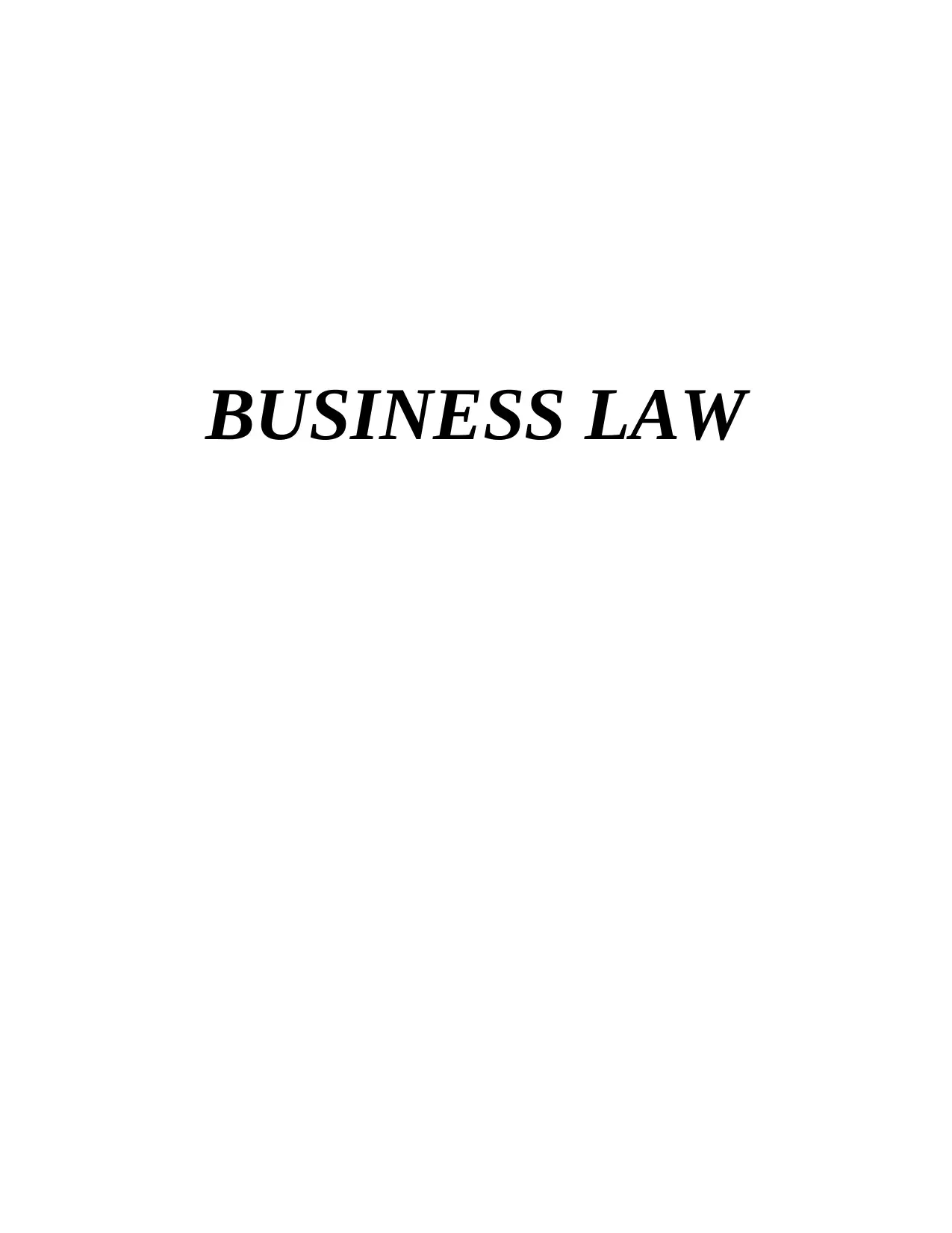
BUSINESS LAW
Paraphrase This Document
Need a fresh take? Get an instant paraphrase of this document with our AI Paraphraser

Table of Contents
INTRODUCTION ..........................................................................................................................2
MAIN BODY...................................................................................................................................3
Sam and his business:..................................................................................................................3
Types of business organisations and their legal consequences:..................................................3
SOLE TRADER- ...................................................................................................................3
PARTNERSHIP-....................................................................................................................4
LIMITED LIABILITY PARTNERSHIP-..............................................................................4
LIMITED COMPANY-.........................................................................................................5
Recommendations on suitable organisation type:.......................................................................5
CONCLUSION ...............................................................................................................................6
REFERENCES................................................................................................................................7
INTRODUCTION ..........................................................................................................................2
MAIN BODY...................................................................................................................................3
Sam and his business:..................................................................................................................3
Types of business organisations and their legal consequences:..................................................3
SOLE TRADER- ...................................................................................................................3
PARTNERSHIP-....................................................................................................................4
LIMITED LIABILITY PARTNERSHIP-..............................................................................4
LIMITED COMPANY-.........................................................................................................5
Recommendations on suitable organisation type:.......................................................................5
CONCLUSION ...............................................................................................................................6
REFERENCES................................................................................................................................7

⊘ This is a preview!⊘
Do you want full access?
Subscribe today to unlock all pages.

Trusted by 1+ million students worldwide
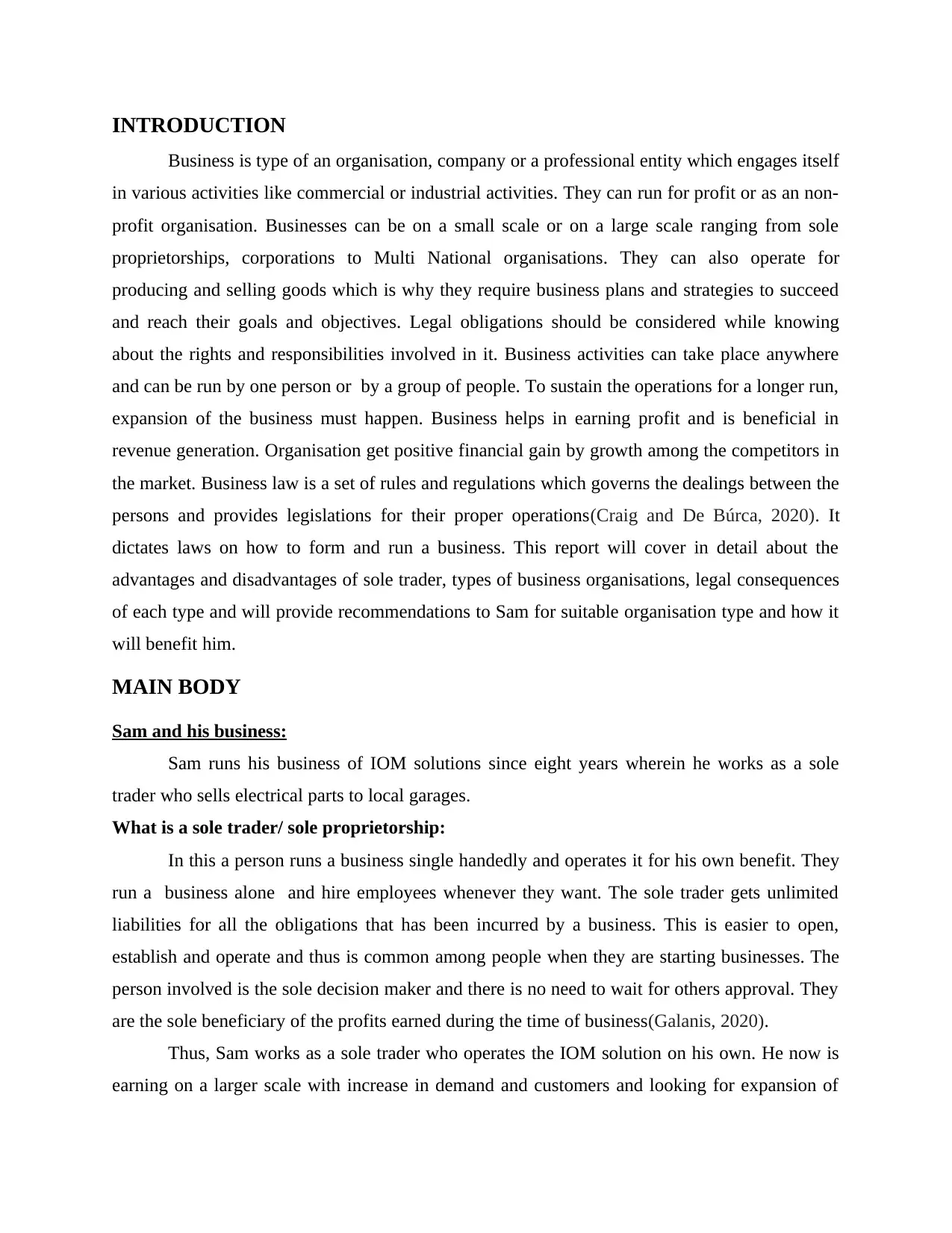
INTRODUCTION
Business is type of an organisation, company or a professional entity which engages itself
in various activities like commercial or industrial activities. They can run for profit or as an non-
profit organisation. Businesses can be on a small scale or on a large scale ranging from sole
proprietorships, corporations to Multi National organisations. They can also operate for
producing and selling goods which is why they require business plans and strategies to succeed
and reach their goals and objectives. Legal obligations should be considered while knowing
about the rights and responsibilities involved in it. Business activities can take place anywhere
and can be run by one person or by a group of people. To sustain the operations for a longer run,
expansion of the business must happen. Business helps in earning profit and is beneficial in
revenue generation. Organisation get positive financial gain by growth among the competitors in
the market. Business law is a set of rules and regulations which governs the dealings between the
persons and provides legislations for their proper operations(Craig and De Búrca, 2020). It
dictates laws on how to form and run a business. This report will cover in detail about the
advantages and disadvantages of sole trader, types of business organisations, legal consequences
of each type and will provide recommendations to Sam for suitable organisation type and how it
will benefit him.
MAIN BODY
Sam and his business:
Sam runs his business of IOM solutions since eight years wherein he works as a sole
trader who sells electrical parts to local garages.
What is a sole trader/ sole proprietorship:
In this a person runs a business single handedly and operates it for his own benefit. They
run a business alone and hire employees whenever they want. The sole trader gets unlimited
liabilities for all the obligations that has been incurred by a business. This is easier to open,
establish and operate and thus is common among people when they are starting businesses. The
person involved is the sole decision maker and there is no need to wait for others approval. They
are the sole beneficiary of the profits earned during the time of business(Galanis, 2020).
Thus, Sam works as a sole trader who operates the IOM solution on his own. He now is
earning on a larger scale with increase in demand and customers and looking for expansion of
Business is type of an organisation, company or a professional entity which engages itself
in various activities like commercial or industrial activities. They can run for profit or as an non-
profit organisation. Businesses can be on a small scale or on a large scale ranging from sole
proprietorships, corporations to Multi National organisations. They can also operate for
producing and selling goods which is why they require business plans and strategies to succeed
and reach their goals and objectives. Legal obligations should be considered while knowing
about the rights and responsibilities involved in it. Business activities can take place anywhere
and can be run by one person or by a group of people. To sustain the operations for a longer run,
expansion of the business must happen. Business helps in earning profit and is beneficial in
revenue generation. Organisation get positive financial gain by growth among the competitors in
the market. Business law is a set of rules and regulations which governs the dealings between the
persons and provides legislations for their proper operations(Craig and De Búrca, 2020). It
dictates laws on how to form and run a business. This report will cover in detail about the
advantages and disadvantages of sole trader, types of business organisations, legal consequences
of each type and will provide recommendations to Sam for suitable organisation type and how it
will benefit him.
MAIN BODY
Sam and his business:
Sam runs his business of IOM solutions since eight years wherein he works as a sole
trader who sells electrical parts to local garages.
What is a sole trader/ sole proprietorship:
In this a person runs a business single handedly and operates it for his own benefit. They
run a business alone and hire employees whenever they want. The sole trader gets unlimited
liabilities for all the obligations that has been incurred by a business. This is easier to open,
establish and operate and thus is common among people when they are starting businesses. The
person involved is the sole decision maker and there is no need to wait for others approval. They
are the sole beneficiary of the profits earned during the time of business(Galanis, 2020).
Thus, Sam works as a sole trader who operates the IOM solution on his own. He now is
earning on a larger scale with increase in demand and customers and looking for expansion of
Paraphrase This Document
Need a fresh take? Get an instant paraphrase of this document with our AI Paraphraser
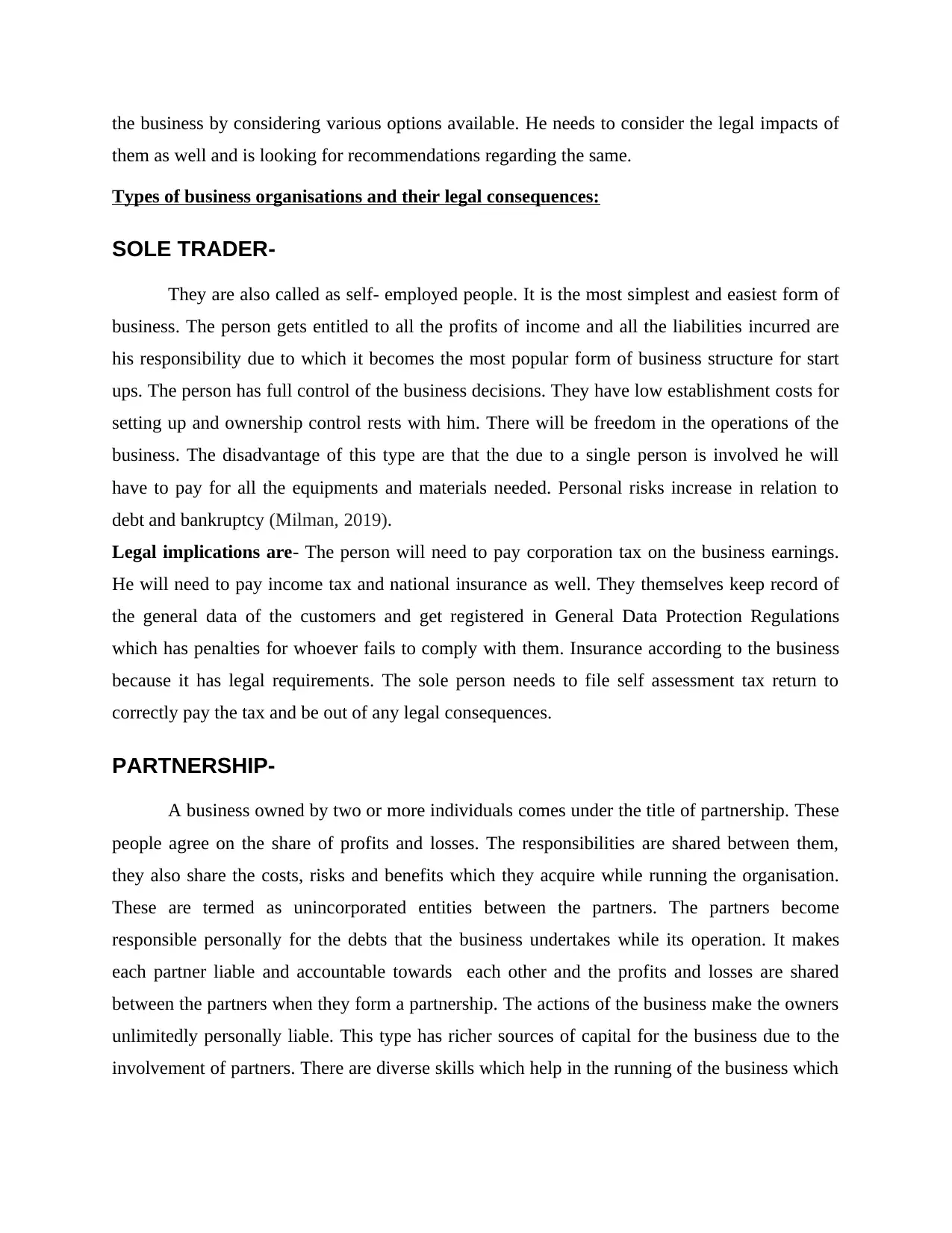
the business by considering various options available. He needs to consider the legal impacts of
them as well and is looking for recommendations regarding the same.
Types of business organisations and their legal consequences:
SOLE TRADER-
They are also called as self- employed people. It is the most simplest and easiest form of
business. The person gets entitled to all the profits of income and all the liabilities incurred are
his responsibility due to which it becomes the most popular form of business structure for start
ups. The person has full control of the business decisions. They have low establishment costs for
setting up and ownership control rests with him. There will be freedom in the operations of the
business. The disadvantage of this type are that the due to a single person is involved he will
have to pay for all the equipments and materials needed. Personal risks increase in relation to
debt and bankruptcy (Milman, 2019).
Legal implications are- The person will need to pay corporation tax on the business earnings.
He will need to pay income tax and national insurance as well. They themselves keep record of
the general data of the customers and get registered in General Data Protection Regulations
which has penalties for whoever fails to comply with them. Insurance according to the business
because it has legal requirements. The sole person needs to file self assessment tax return to
correctly pay the tax and be out of any legal consequences.
PARTNERSHIP-
A business owned by two or more individuals comes under the title of partnership. These
people agree on the share of profits and losses. The responsibilities are shared between them,
they also share the costs, risks and benefits which they acquire while running the organisation.
These are termed as unincorporated entities between the partners. The partners become
responsible personally for the debts that the business undertakes while its operation. It makes
each partner liable and accountable towards each other and the profits and losses are shared
between the partners when they form a partnership. The actions of the business make the owners
unlimitedly personally liable. This type has richer sources of capital for the business due to the
involvement of partners. There are diverse skills which help in the running of the business which
them as well and is looking for recommendations regarding the same.
Types of business organisations and their legal consequences:
SOLE TRADER-
They are also called as self- employed people. It is the most simplest and easiest form of
business. The person gets entitled to all the profits of income and all the liabilities incurred are
his responsibility due to which it becomes the most popular form of business structure for start
ups. The person has full control of the business decisions. They have low establishment costs for
setting up and ownership control rests with him. There will be freedom in the operations of the
business. The disadvantage of this type are that the due to a single person is involved he will
have to pay for all the equipments and materials needed. Personal risks increase in relation to
debt and bankruptcy (Milman, 2019).
Legal implications are- The person will need to pay corporation tax on the business earnings.
He will need to pay income tax and national insurance as well. They themselves keep record of
the general data of the customers and get registered in General Data Protection Regulations
which has penalties for whoever fails to comply with them. Insurance according to the business
because it has legal requirements. The sole person needs to file self assessment tax return to
correctly pay the tax and be out of any legal consequences.
PARTNERSHIP-
A business owned by two or more individuals comes under the title of partnership. These
people agree on the share of profits and losses. The responsibilities are shared between them,
they also share the costs, risks and benefits which they acquire while running the organisation.
These are termed as unincorporated entities between the partners. The partners become
responsible personally for the debts that the business undertakes while its operation. It makes
each partner liable and accountable towards each other and the profits and losses are shared
between the partners when they form a partnership. The actions of the business make the owners
unlimitedly personally liable. This type has richer sources of capital for the business due to the
involvement of partners. There are diverse skills which help in the running of the business which

leads to improved overall performance. The disadvantage is of joint and several liability which
comes upon the partners.
Legal implications are- Partnerships in UK are governed by the Partnership act of 1890. The
common law imposes duty on the partners to act fairly and in good faith. In the act it is laid
down that the responsibilities and decisions will be shared by the partners. Equal contribution to
the business is the right of each partner. A partnership agreement is created for the application of
the provisions (Sameer, 2021). The partnership can be dissolved by giving a notice of dissolution
to the partner. Even if the partnership agreement is absent, the entire partnership can be dissolved
by illegality, death or bankruptcy of a partner. The partners thus have rights and duties towards
each other.
LIMITED LIABILITY PARTNERSHIP-
These are not legally treated as partnerships in UK. But these are kind of similar to
partnerships except on the fact that here a partner's obligation is limited to the amount of money
that they spend in the business. These must register themselves at the companies house. This
partnership can be incorporated by two or more members. They have limited liabilities and are
therefore responsible for their own misconduct or negligence. They are not collectively
responsible towards anything. The company must be in accordance with the government
regulations and must have a registered office in UK. In this type, the partners are allowed to
directly carry off the business. It is a type of business under separate legal entities which provide
certain legal protections to the individuals involved. This type of business system protects the
owner from business non accomplishment.
Legal implications are- Limited Partnerships are covered under the Limited Partnership Act
1907. Here the persons involved are jointly and severally liable for the finances, debts and
obligations of the limited partnership and are thus called as General partners (Schroeder, 2019) .
This is in a way constituted by an agreement in the written form. The partnership should not be
bounded for it to be limited.
LIMITED COMPANY-
It is a type of business which is privately managed and operated. It is run by its directors
and owned by its shareholders. It is a type of company which is a separate legal entity which has
comes upon the partners.
Legal implications are- Partnerships in UK are governed by the Partnership act of 1890. The
common law imposes duty on the partners to act fairly and in good faith. In the act it is laid
down that the responsibilities and decisions will be shared by the partners. Equal contribution to
the business is the right of each partner. A partnership agreement is created for the application of
the provisions (Sameer, 2021). The partnership can be dissolved by giving a notice of dissolution
to the partner. Even if the partnership agreement is absent, the entire partnership can be dissolved
by illegality, death or bankruptcy of a partner. The partners thus have rights and duties towards
each other.
LIMITED LIABILITY PARTNERSHIP-
These are not legally treated as partnerships in UK. But these are kind of similar to
partnerships except on the fact that here a partner's obligation is limited to the amount of money
that they spend in the business. These must register themselves at the companies house. This
partnership can be incorporated by two or more members. They have limited liabilities and are
therefore responsible for their own misconduct or negligence. They are not collectively
responsible towards anything. The company must be in accordance with the government
regulations and must have a registered office in UK. In this type, the partners are allowed to
directly carry off the business. It is a type of business under separate legal entities which provide
certain legal protections to the individuals involved. This type of business system protects the
owner from business non accomplishment.
Legal implications are- Limited Partnerships are covered under the Limited Partnership Act
1907. Here the persons involved are jointly and severally liable for the finances, debts and
obligations of the limited partnership and are thus called as General partners (Schroeder, 2019) .
This is in a way constituted by an agreement in the written form. The partnership should not be
bounded for it to be limited.
LIMITED COMPANY-
It is a type of business which is privately managed and operated. It is run by its directors
and owned by its shareholders. It is a type of company which is a separate legal entity which has
⊘ This is a preview!⊘
Do you want full access?
Subscribe today to unlock all pages.

Trusted by 1+ million students worldwide

its own governing legal rights and obligations. It is the responsibility of the company for
everything it does even the finances are separate from personal affairs. The company retains all
the profit it generates. By the way of dividends the profits are distributed to its shareholder. It
can be further divided into two types which are limited by shares and private company limited by
guarantee. The former one is the most commonly used for business ventures and the latter one
has at least one director for its operation(Shome, 2018) .
Legal implications are- These companies are registered under the Companies Act of 2006. it
provides a corporate personality to the company which makes it a legal entity wherein there are
rights and obligations to be performed by the company. It is statutory for the company to file the
return of company's accounts to companies house. The duties of a director in a limited company
are codified in the companies act. A shareholder's agreement should be created for the owners. A
memorandum of association is created which outlines the agreement of shareholders to form a
limited company. Written rules of the company must be set.
Recommendations on suitable organisation type:
As there are developments and growth in the business, it can be good to change the
structure of the business into a limited company. Considerable expansion in the business makes
this type an appropriate option. In this the person will be able to hire more staff and divide the
responsibilities between them. Limited companies are more tax efficient compared to a sole
trader. Due to the limited liabilities involved it is beneficial to a business owner in terms of
liabilities(Tonthat, 2017). This is why Sam should opt for this type of business structure. The
personal finances are protected by the law and thus interests will be protected in case a business
incurs debts. A limited company is registered as a separate legal entity in the eyes of the law
which is not available in being a sole trader. Business actions can be made liable by way of
contracts and interests of the directors can be protected.
In being a sole trader, the business is not officially registered due to which anyone can
use the name of the business against which no legal action could be taken. Thus, limited
company is better in this context. The business image of the company becomes prestigious due to
being known as a limited company. They appear as professional businesses which engages the
customers and attracts them towards it. It is easier for the owners of the company to acquire
loans from banks and fund themselves which makes the business secure in the longer run. It
limits the personal liability wherein the clients and the employee enter into a contract with the
everything it does even the finances are separate from personal affairs. The company retains all
the profit it generates. By the way of dividends the profits are distributed to its shareholder. It
can be further divided into two types which are limited by shares and private company limited by
guarantee. The former one is the most commonly used for business ventures and the latter one
has at least one director for its operation(Shome, 2018) .
Legal implications are- These companies are registered under the Companies Act of 2006. it
provides a corporate personality to the company which makes it a legal entity wherein there are
rights and obligations to be performed by the company. It is statutory for the company to file the
return of company's accounts to companies house. The duties of a director in a limited company
are codified in the companies act. A shareholder's agreement should be created for the owners. A
memorandum of association is created which outlines the agreement of shareholders to form a
limited company. Written rules of the company must be set.
Recommendations on suitable organisation type:
As there are developments and growth in the business, it can be good to change the
structure of the business into a limited company. Considerable expansion in the business makes
this type an appropriate option. In this the person will be able to hire more staff and divide the
responsibilities between them. Limited companies are more tax efficient compared to a sole
trader. Due to the limited liabilities involved it is beneficial to a business owner in terms of
liabilities(Tonthat, 2017). This is why Sam should opt for this type of business structure. The
personal finances are protected by the law and thus interests will be protected in case a business
incurs debts. A limited company is registered as a separate legal entity in the eyes of the law
which is not available in being a sole trader. Business actions can be made liable by way of
contracts and interests of the directors can be protected.
In being a sole trader, the business is not officially registered due to which anyone can
use the name of the business against which no legal action could be taken. Thus, limited
company is better in this context. The business image of the company becomes prestigious due to
being known as a limited company. They appear as professional businesses which engages the
customers and attracts them towards it. It is easier for the owners of the company to acquire
loans from banks and fund themselves which makes the business secure in the longer run. It
limits the personal liability wherein the clients and the employee enter into a contract with the
Paraphrase This Document
Need a fresh take? Get an instant paraphrase of this document with our AI Paraphraser
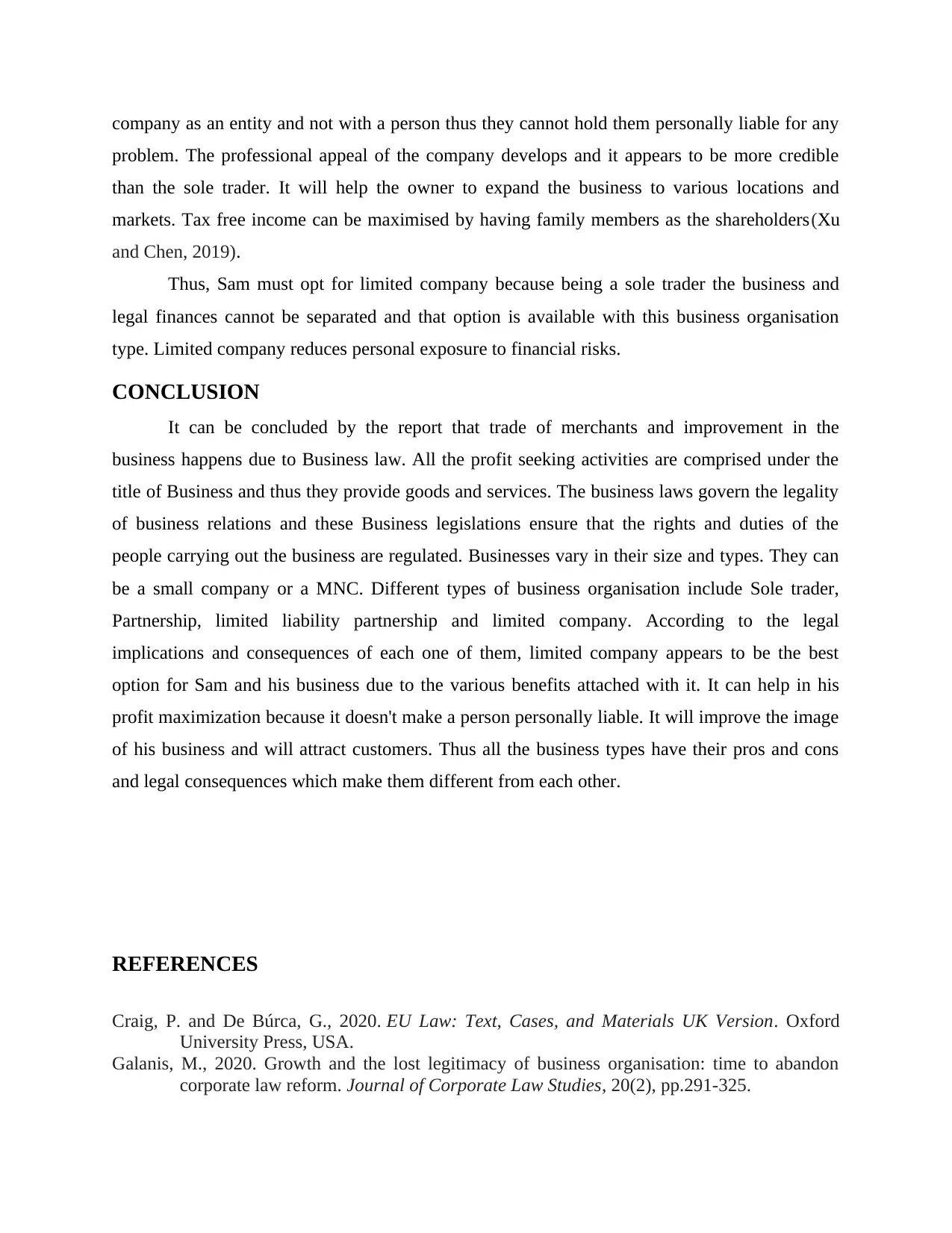
company as an entity and not with a person thus they cannot hold them personally liable for any
problem. The professional appeal of the company develops and it appears to be more credible
than the sole trader. It will help the owner to expand the business to various locations and
markets. Tax free income can be maximised by having family members as the shareholders(Xu
and Chen, 2019).
Thus, Sam must opt for limited company because being a sole trader the business and
legal finances cannot be separated and that option is available with this business organisation
type. Limited company reduces personal exposure to financial risks.
CONCLUSION
It can be concluded by the report that trade of merchants and improvement in the
business happens due to Business law. All the profit seeking activities are comprised under the
title of Business and thus they provide goods and services. The business laws govern the legality
of business relations and these Business legislations ensure that the rights and duties of the
people carrying out the business are regulated. Businesses vary in their size and types. They can
be a small company or a MNC. Different types of business organisation include Sole trader,
Partnership, limited liability partnership and limited company. According to the legal
implications and consequences of each one of them, limited company appears to be the best
option for Sam and his business due to the various benefits attached with it. It can help in his
profit maximization because it doesn't make a person personally liable. It will improve the image
of his business and will attract customers. Thus all the business types have their pros and cons
and legal consequences which make them different from each other.
REFERENCES
Craig, P. and De Búrca, G., 2020. EU Law: Text, Cases, and Materials UK Version. Oxford
University Press, USA.
Galanis, M., 2020. Growth and the lost legitimacy of business organisation: time to abandon
corporate law reform. Journal of Corporate Law Studies, 20(2), pp.291-325.
problem. The professional appeal of the company develops and it appears to be more credible
than the sole trader. It will help the owner to expand the business to various locations and
markets. Tax free income can be maximised by having family members as the shareholders(Xu
and Chen, 2019).
Thus, Sam must opt for limited company because being a sole trader the business and
legal finances cannot be separated and that option is available with this business organisation
type. Limited company reduces personal exposure to financial risks.
CONCLUSION
It can be concluded by the report that trade of merchants and improvement in the
business happens due to Business law. All the profit seeking activities are comprised under the
title of Business and thus they provide goods and services. The business laws govern the legality
of business relations and these Business legislations ensure that the rights and duties of the
people carrying out the business are regulated. Businesses vary in their size and types. They can
be a small company or a MNC. Different types of business organisation include Sole trader,
Partnership, limited liability partnership and limited company. According to the legal
implications and consequences of each one of them, limited company appears to be the best
option for Sam and his business due to the various benefits attached with it. It can help in his
profit maximization because it doesn't make a person personally liable. It will improve the image
of his business and will attract customers. Thus all the business types have their pros and cons
and legal consequences which make them different from each other.
REFERENCES
Craig, P. and De Búrca, G., 2020. EU Law: Text, Cases, and Materials UK Version. Oxford
University Press, USA.
Galanis, M., 2020. Growth and the lost legitimacy of business organisation: time to abandon
corporate law reform. Journal of Corporate Law Studies, 20(2), pp.291-325.
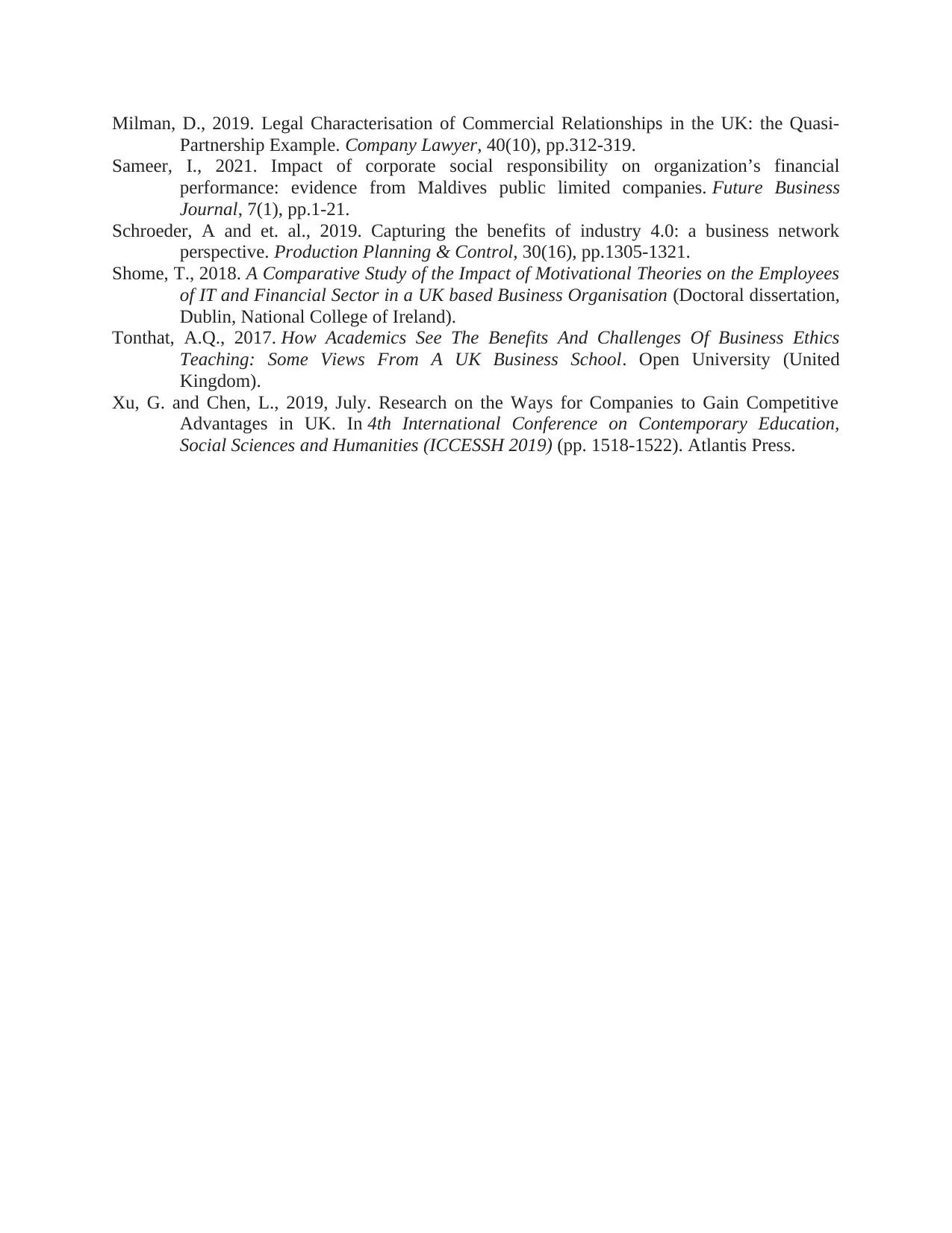
Milman, D., 2019. Legal Characterisation of Commercial Relationships in the UK: the Quasi-
Partnership Example. Company Lawyer, 40(10), pp.312-319.
Sameer, I., 2021. Impact of corporate social responsibility on organization’s financial
performance: evidence from Maldives public limited companies. Future Business
Journal, 7(1), pp.1-21.
Schroeder, A and et. al., 2019. Capturing the benefits of industry 4.0: a business network
perspective. Production Planning & Control, 30(16), pp.1305-1321.
Shome, T., 2018. A Comparative Study of the Impact of Motivational Theories on the Employees
of IT and Financial Sector in a UK based Business Organisation (Doctoral dissertation,
Dublin, National College of Ireland).
Tonthat, A.Q., 2017. How Academics See The Benefits And Challenges Of Business Ethics
Teaching: Some Views From A UK Business School. Open University (United
Kingdom).
Xu, G. and Chen, L., 2019, July. Research on the Ways for Companies to Gain Competitive
Advantages in UK. In 4th International Conference on Contemporary Education,
Social Sciences and Humanities (ICCESSH 2019) (pp. 1518-1522). Atlantis Press.
Partnership Example. Company Lawyer, 40(10), pp.312-319.
Sameer, I., 2021. Impact of corporate social responsibility on organization’s financial
performance: evidence from Maldives public limited companies. Future Business
Journal, 7(1), pp.1-21.
Schroeder, A and et. al., 2019. Capturing the benefits of industry 4.0: a business network
perspective. Production Planning & Control, 30(16), pp.1305-1321.
Shome, T., 2018. A Comparative Study of the Impact of Motivational Theories on the Employees
of IT and Financial Sector in a UK based Business Organisation (Doctoral dissertation,
Dublin, National College of Ireland).
Tonthat, A.Q., 2017. How Academics See The Benefits And Challenges Of Business Ethics
Teaching: Some Views From A UK Business School. Open University (United
Kingdom).
Xu, G. and Chen, L., 2019, July. Research on the Ways for Companies to Gain Competitive
Advantages in UK. In 4th International Conference on Contemporary Education,
Social Sciences and Humanities (ICCESSH 2019) (pp. 1518-1522). Atlantis Press.
⊘ This is a preview!⊘
Do you want full access?
Subscribe today to unlock all pages.

Trusted by 1+ million students worldwide
1 out of 9
Related Documents
Your All-in-One AI-Powered Toolkit for Academic Success.
+13062052269
info@desklib.com
Available 24*7 on WhatsApp / Email
![[object Object]](/_next/static/media/star-bottom.7253800d.svg)
Unlock your academic potential
Copyright © 2020–2025 A2Z Services. All Rights Reserved. Developed and managed by ZUCOL.




